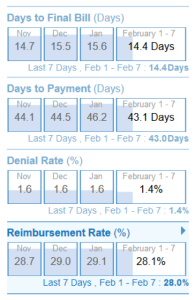 One of the things we are worried about is how ICD-10 implementation affects reimbursements for healthcare providers. And since Oct. 1, we’ve saying it’s too early to tell.
One of the things we are worried about is how ICD-10 implementation affects reimbursements for healthcare providers. And since Oct. 1, we’ve saying it’s too early to tell.
That’s mostly because we are getting glimpses of the overall picture. It’s a bit like the blind men with their hands on different pieces of an elephant.
Chris Nerney, Managing Editor of Revenue Cycle Insights, got one of those glimpses by comparing key performance indicators (KPIs) based on data provided by RelayHealth’s ICD-10 Central Metrics tab.
Basically, he found days to final bill (DTFB) dropped to 14.4 days in the first week of February. That’s more than one day difference from December’s and January’s DTFBs. And the days to payment (DTP) and denial rates improved in the same period.
I understand this is only one source of information and that one week in February doesn’t make a trend.
Especially when you see that the reimbursement rates dropped in February.
I also am suspect of any kind of measurement taken in December. The holidays tend to impact all kinds of activity and productivity. People take more time off from work and businesses that aren’t retail tend to decrease hours and activity.
So for now, we have a glimpse of what’s going on. What are you seeing?
——————————————————
Photo courtesy of: ICD10 Watch
Originally Published On: ICD-10 Watch
Follow Medical Coding Pro on Twitter: www.Twitter.com/CodingPro1
Like Us On Facebook: www.Facebook.com/MedicalCodingPro






